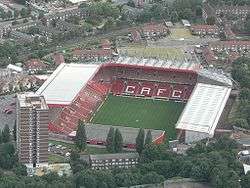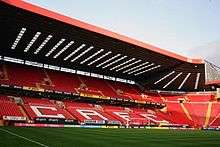The Valley (London)
| Floyd Road | |
 Aerial view of the stadium in 2008 | |
| Location |
Charlton London, SE7 England |
|---|---|
| Coordinates | 51°29′11″N 0°2′11″E / 51.48639°N 0.03639°ECoordinates: 51°29′11″N 0°2′11″E / 51.48639°N 0.03639°E |
| Public transit |
|
| Owner | Charlton Athletic F.C. |
| Capacity | 27,111 |
| Field size | 112 yd × 73 yd (102 m × 67 m) |
| Surface | Grass |
| Construction | |
| Broke ground | 1919 |
| Opened | 1919 |
| Renovated | 1991 |
| Expanded |
1994: east stand re-built 1998: west stand re-built 2001: north stand re-built |
| Closed | 1985–1992 |
| Tenants | |
|
Charlton Athletic Football Club (1919–1985, 1992–present) London Broncos Rugby League Football Club (1996–1997, 1999–2000) Sidemen F.C. (Charity Matches) (2017-2018) | |
The Valley is a 27,111-capacity sports stadium located in Charlton, London, England and is the home of Charlton Athletic Football Club.
History
In Charlton's early years, the club had a nomadic existence using several different grounds between its formation in 1905 and the beginning of World War I in 1914. The ground dates from 1919, at a time when Charlton were moderately successful and looking for a new home. The club found an abandoned sand and chalk pit in Charlton, but did not have sufficient funds to fully develop the site. An army of volunteer Charlton supporters dug out a flat area for the pitch at the bottom of the chalk pit and used the excavated material to build up makeshift stands. The ground's name most likely comes from its original valley-like appearance. The club played its first game at the ground before any seats, or even terraces, were installed; there was simply a roped-off pitch with the crowd standing or sitting on the adjoining earthworks. The unique circumstances of the ground's initial construction led to an unusually intense bond between the club's supporters and the site that exists to this day. In the 1923–24 season, Charlton played at the Mount stadium in Catford but in a much more highly populated area. A proposed merger with Catford South End FC fell through and thus Charlton moved back to the Valley.
In 1967, Len Silver the promoter at Hackney made an application to open Charlton as a British League speedway club, and plans were put forward to construct a track around the perimeter of the football pitch. The application to include speedway at the Valley was enthusiastically supported initially, but was eventually ruled out on the grounds of noise nuisance.
For many years, the Valley was one of the largest Football League grounds in Britain, although its highest maximum capacity of 75,000 was only half the capacity of Glasgow's Hampden Park.[1] However, Charlton's long absence from the top level of English football prevented much-needed renovation. Eventually, the club's debts led to bankruptcy administration. A consortium of supporters successfully acquired the club in 1984, but the Valley remained under the ownership of the club's former owner. However, the club was unable to finance the improvements needed to make the Valley meet new safety requirements. Shortly after the start of the 1985-86 season, Charlton left the Valley, entering into an agreement with Crystal Palace to share the latter's Selhurst Park facilities, the first official groundsharing arrangement in the Football League in 36 years. In 1988, the ownership of the club and the Valley was again united, and in a "grass roots" effort that harkened back to the ground's initial construction, thousands of supporters volunteered to clean the ground, eventually burning the debris in a huge bonfire on the pitch. By this time, however, the large terraces were no longer seen as desirable or safe. Charlton Athletic supporters then proposed a brand-new stadium to surround the original pitch. However, the Greenwich Borough Council overwhelmingly turned down plans to renovate the ground. Club supporters formed their own local political party, the Valley Party, in response to the council's decision. The party ran candidates for all but two Greenwich Council seats, sparing the two councillors who had approved the new stadium plans. The party won almost 15,000 votes in the 1990 elections,[1] successfully pressuring the council to approve the plans for the new stadium.
In 1991, construction began on the new Valley, and the club moved from Selhurst Park to West Ham's Upton Park. The modern stadium opened in December 1992. Since Charlton's return to the Valley in 1992, the ground itself has undergone some remarkable changes. The north, east and west sides of the ground have almost been completely rebuilt, giving the ground a capacity of over 27,000. The club have ambitions to extend the ground's capacity to over 40,000 by expanding the east side and completely rebuilding the south side,[2] but it remains uncertain if or when the plans will be implemented after the club's relegation from the Premier League in 2007 and from the Championship two years later.
In 2004 the Unity Cup was held at the Valley with Nigeria winning the competition.
On 21 May 2017, the second annual Sidemen charity match was held there, with Sidemen FC taking on the "YouTube All Stars".[3][4] The "YouTube All Stars" won the match 2-0 over Sidemen FC. The Sidemen also held their third annual match at the same venue on 2 June 2018, with Sidemen FC beating the "YouTube All Stars" 7-1.[5]
Stands
The Covered End
Capacity: 9,000

The North Stand was built as a replacement for the 'covered end', and is still called by this name. It was built during the 2001–02 season as part of the developments to bring the Valley's capacity to 26,500 after promotion to the Premier League in 2000. The North Stand houses what is considered the most vocal supporters in the ground, along with restaurants and executive suites. It is also the home of the club's band, which includes drummers and trumpeters.
East Stand
Capacity: 6,000
.jpg)
The East Stand was constructed during the 1993–94 season and fully completed in 1994. As part of the first development to the ground since the return in 1992, it replaced the massive east terrace, which had remained closed and prohibited from use since the mid-1980s after the Bradford City stadium fire. The East Stand consists of a single tier of seats and houses the television gantry, and also has numerous executive boxes. Occasionally, for FA and League Cup matches, part of the East Stand is used to house away supporters if the demand for away team tickets is high.
West Stand
Capacity: 9,000
.jpg)
The West Stand was built in 1998 after Charlton's first promotion to the Premier League and is also two tiered. This is the main stand at the Valley with the largest capacity, and also houses the club's offices, as well as the director's box, board room dug-outs, changing rooms and the commercial centre (ticket office). There are also many conferencing rooms in this stand which are used for official and community events. There is a large statue of Sam Bartram, (considered to be Charlton's finest player) at the entrance of the West Stand.
Jimmy Seed Stand
Capacity: 3,000
%2CThe_Valley_(London).jpg)
The Jimmy Seed (or South) Stand is the oldest part of the ground, and dates from the early 1980s. This stand is named after Charlton's manager, Jimmy Seed – with whom Charlton won the FA Cup in 1947. This stand has a capacity of around 3,000 and hosts the away supporters at games. It is also the only part of the Valley with a supporting pillar.
Details
Records
- Loudest rock concert ever: The Who, 31 May 1976 – 126 db, measured at a distance of 32 metres (105 ft) from the speakers.[6]
- Record Attendance: 75,031 v Aston Villa, 12 February 1938 (FA Cup Fifth Round)
- Record League Attendance: 68,160 v Arsenal, 17 October 1936 (Football League First Division)
- Record All-seater Attendance: 27,111 v Chelsea, 17 September 2005; v Tottenham Hotspur, 1 October 2005; v Liverpool, 16 December 2006; v Chelsea, 3 February 2007; v West Ham United, 24 February 2007; v Sheffield United, 21 April 2007 (all Premier League)
Average attendances
The Valley's highest average attendance came in the 1948-49 season when crowds averaged 40,216, making Charlton one of only thirteen clubs in English football to achieve a seasonal average of 40,000+. The Valley's lowest average attendance is 5,108 from the 1984-85 season.
Highest
| Season | Average | Division |
|---|---|---|
| 1948-49 | 40,216 | |
| 1947-48 | 36,248 | |
| 1949-50 | 34,567 | |
| 1946-47 | 32,401 | |
| 1936-37 | 31,086 | |
Lowest
| Season | Average | Division |
|---|---|---|
| 1984-85 | 5,104 | |
| 1973-74 | 5,306 | |
| 1972-73 | 5,658 | |
| 1922-23 | 6,175 | |
| 1981-82 | 6,649 | |
Average attendance for every season since 1993–94, the first full season since Charlton returned to the Valley.
| Season | Average | Division |
|---|---|---|
| 1993–94 | 8,056 | |
| 1994–95 | 10,216 | |
| 1995–96 | 11,185 | |
| 1996–97 | 11,081 | |
| 1997–98 | 13,275 | |
| 1998–99 | 19,823 | Premier League |
| 1999–2000 | 19,541 | First Division |
| 2000–01 | 20,020 | |
| 2001–02 | 24,135 | |
| 2002–03 | 26,235 | |
| 2003–04 | 26,278 | |
| 2004–05 | 26,378 | |
| 2005–06 | 26,171 | |
| 2006–07 | 26,197 | |
| 2007–08 | 23,159 | |
| 2008–09 | 20,894 | |
| 2009–10 | 17,407 | |
| 2010–11 | 15,582 | |
| 2011–12 | 17,485 | |
| 2012–13 | 18,499 | Championship |
| 2013–14 | 16,134 | |
| 2014–15 | 16,708 | |
| 2015–16 | 15,632 | |
| 2016–17 | 11,162 | League One |
| 2017–18 | 11,846 |
References
- 1 2 "Details about Charlton Athletic". BBC London. Retrieved 17 July 2007.
- ↑ "Expansion plans underway". Charlton Athletic F.C. 29 November 2004. Archived from the original on 27 September 2007. Retrieved 17 July 2007.
- ↑ Youlton, Clive (14 March 2017). "Charlton Athletic: Your chance to see YouTube stars at The Valley". KentLive. Local World. Retrieved 23 March 2017.
- ↑ Kent, Mike (17 March 2017). "YouTube Secure Streaming Rights for Annual Sidemen Charity Football Stream". Dexerto. Retrieved 23 March 2017.
- ↑ Kent, Mike (2 June 2018). "Sidemen FC vs YouTube Allstars Charity Match - Match Report and VoD - KSI, FaZe Adapt and more!". Dexerto. Retrieved 3 June 2018.
External links
| Wikimedia Commons has media related to The Valley. |
- Aerial shot of the Valley
- Stadium Plan www.cafc.co.uk